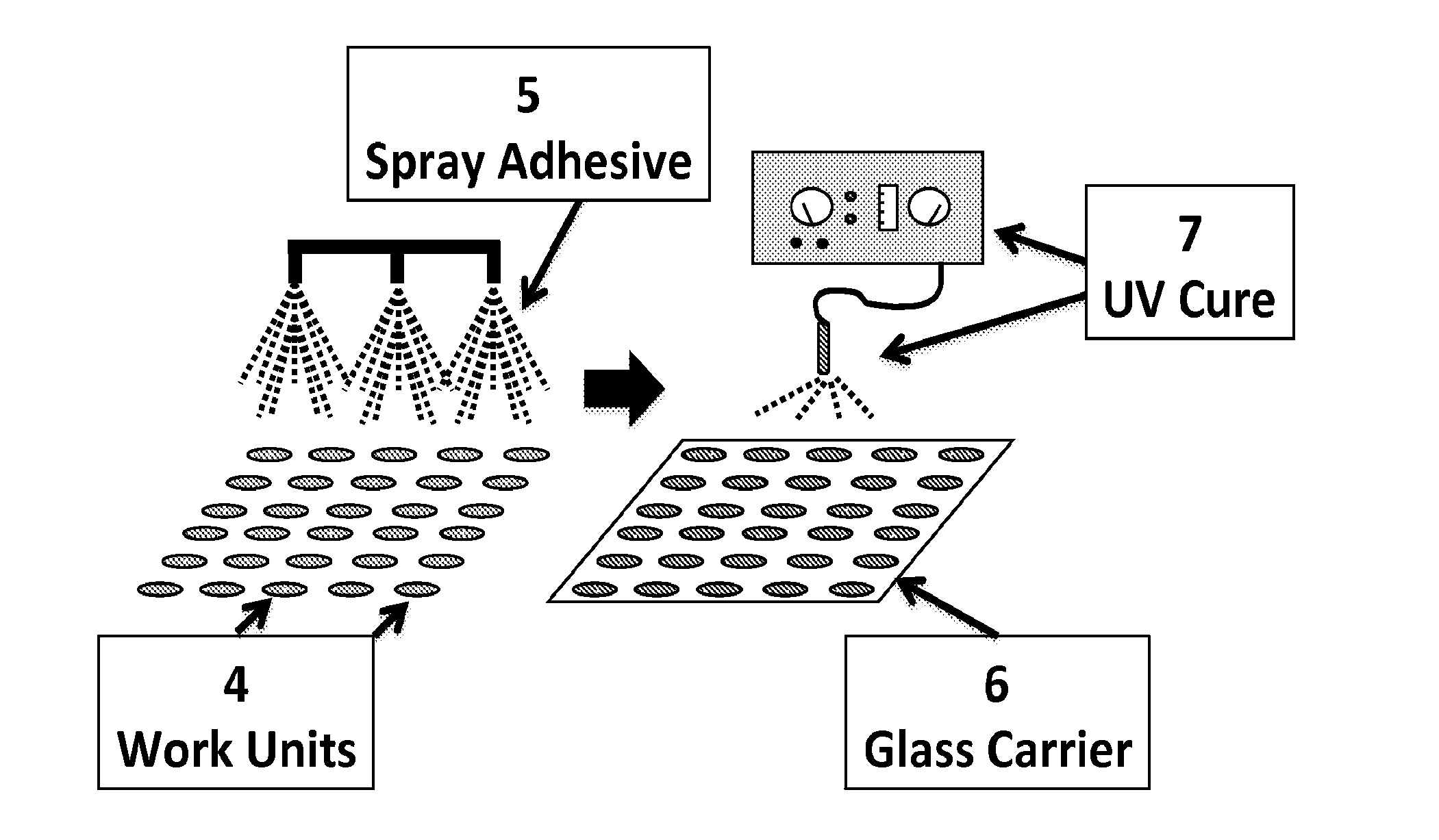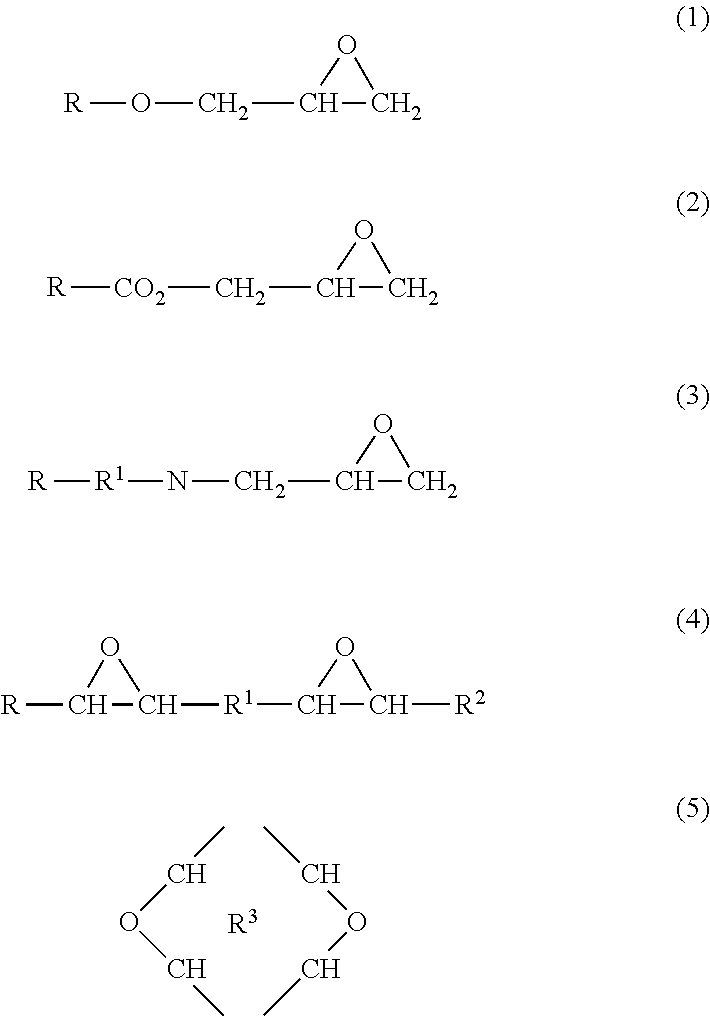Aqueous detergent soluble coating and adhesive and methods of temporary bonding for manufacturing
a technology of detergent soluble coating and adhesive, applied in the direction of amide/imide polymer adhesive, synthetic resin layered products, non-macromolecular adhesive additives, etc., can solve the problems of increasing the impedance of device performance, undue stress on the work unit, etc., to reduce waste generation, improve the compatibility of tools, and reduce the effect of cost and complexity
- Summary
- Abstract
- Description
- Claims
- Application Information
AI Technical Summary
Benefits of technology
Problems solved by technology
Method used
Image
Examples
examples
[0066]The compositions of the invention and the method of making of the examples are described. It is understood, however, that the invention is not meant to be limited to the details described therein. In the examples, the percentages provided are percent (%) by weight unless otherwise stated. The invention is further illustrated, without limitation, by the following examples. The measurement of performance and selectivity of the invention is conducted using practices readily accepted by the industry.
[0067]Coatings are produced on a Brewer Science, Inc. CB-100 spin-coater, while spray and encapsulation uses custom tooling designed at Daetec. Metrology data is generated by a XP-1 stylus profiler, AFP-200 atomic force profiler, and a Xi-100 optical profiler (www.kla-tencor.com), using equipment settings 5 mg stylus load, minimum 4 mm distance, and a speed of 0.5 mm / sec. Modified thermogravimetric test methodology for outgas is conducted by typical laboratory scales (+ / −0.1 mg). UV cu...
example # 1
Example #1
[0069]This experiment demonstrates the use of various Lewis concept acids of the variety carboxylic acid (organic acid) as applied as coatings. Water solubility is tested and thermal resistance is indicated for each material. Most of the acids listed here exhibit dissociation values of ≧1×10−5 (pKa≦5). The listing and results are in Table 1.
TABLE 1Acidic products of the Lewis acid variety (carboxylic acids)and their results for water and detergency solubility. Materialsare dissolved in solvents n,n-dimethylacetamide (DMAC).WaterDetergencySofteningsolubility(KOH based#Coating (acidic)Point (C.)(observed)system)11,4-CHDA HP (CAS#165Limited / noYes1076-92-7)2Sokalan DCS (CAS#120Limited / noYes686603-87-2)3Isophthalic acid300Limited / noYes(CAS# 121-91-5)4Terephthalic acid300Limited / noPartial(CAS# 100-21-0)5P-hydroxybenzoic213Limited / noYesacid (CAS# 99-96-764-Chlorobenzoic acid240Limited / noYes(CAS# 74-11-3)7Fumaric Acid (CAS#300Limited / noPartial110-17-9)8Phthalic Acid (CAS#210Limite...
example # 2
Example #2
[0070]Silicone resin intermediate Dow Corning Z-6018 (www.dowcorning) and siloxane Dynasylan 4148 (www.evonik.com) are mixed to determine detergency effect and effects to reduce outgas. Nanoparticle silica as Aerosil R90 (treated silica, Evonik) is used to further condensation of the silicone. Materials are mixed and applied to glass slides (2″×3″), apply 0.25 g of a 25% solids solution. Materials are cured 130 C, 5 min, and 250 C 15 min. Thermal exposures are tested for outgas as material weight loss. Detergent is a standard KOH based system. The results for de-bond are listed in Table 2.
TABLE 2Thermal resistance as outgas weight % loss and detergency for severalmixtures of tunable acid coating and adhesive for aqueous detergencyremoval for a silicone resin / polysiloxane.Additives are reviewed for capability to reduce outgassing.Additive &250 C.350 C.350 C. +WaterDetergency#amount30 min30 min30 minSolubleSoluble1Base -0-95.488.786.0NoYesadditive2Acid93.283.680.5NoYesadditi...
PUM
| Property | Measurement | Unit |
|---|---|---|
| Flexibility | aaaaa | aaaaa |
| Acidity | aaaaa | aaaaa |
| Semiconductor properties | aaaaa | aaaaa |
Abstract
Description
Claims
Application Information
 Login to View More
Login to View More - R&D
- Intellectual Property
- Life Sciences
- Materials
- Tech Scout
- Unparalleled Data Quality
- Higher Quality Content
- 60% Fewer Hallucinations
Browse by: Latest US Patents, China's latest patents, Technical Efficacy Thesaurus, Application Domain, Technology Topic, Popular Technical Reports.
© 2025 PatSnap. All rights reserved.Legal|Privacy policy|Modern Slavery Act Transparency Statement|Sitemap|About US| Contact US: help@patsnap.com



